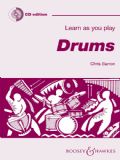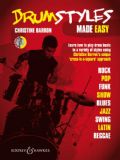
Christine Barron
Drum Styles Made Easy: in conversation with composer Christine Barron (July 2009)
It’s been 20 years since the launch of Christine’s award-winning tutor books for Boosey & Hawkes – Learn As You Play Drums and Learn As You Play Tuned Percussion & Timpani - which continues to attract praise from the percussion world and has been described by Evelyn Glennie as "a wonderful contribution to percussion education". We caught up with Christine to ask her what lies behind her newly released drum book entitled ‘Drum Styles Made Easy’.
Christine, why did you write ‘Drum Styles Made Easy’?
I wrote the book because I wanted to give student drummers an insight into the many challenging types of music today. There are more varieties of music existing now than ever before, and music is continually evolving into different styles and forms. I think therefore that an ‘all round drummer’ is an asset, and essential for their ability to play in these many styles. A drummer should need to know for example, how to play rhythms for contemporary rock and pop, funk, blues, jazz, Latin, Caribbean and African music and many other styles in order to become an accomplished musician. I also wanted the book to help students who are entering their drum kit examinations, as these exams themselves are becoming increasingly challenging, covering as broad a style base as possible.
What inspired you to write the book in the first place?
Throughout my career, I have always enjoyed the challenge of playing different styles of music through working in bands, theatre, backing live cabaret and so on. To be honest, I find it’s much more fun and it stops me from becoming bored! As a percussion teacher, I find that my students enjoy these challenges too, so over time, I have tried and tested many different styles of music on them. Then I decided it was time to develop this further by bringing together all the exercises and styles into book form for students and teachers to work from.
Who is the book aimed at?
For drummers who want to learn an easier way of playing a variety of different drum kit styles from intermediate level to grade 8.
What can students and teachers expect from the book?
First of all they will find that the book is a comprehensive resource for drummers who want to learn the many different styles required of the modern kit drummer, and which require complete four-way co-ordination between hands and feet. Each chapter of the book starts off by giving the readers a brief history of the style of music they will be learning. Following this, the chapter then shows easy to understand ways of enabling students to combine both hands and feet, using the unique ‘cross-in-a-square’ method – similar to drum tabs (drum kit notation). Each exercise in the book then shows students how the drum kit notes are placed onto the stave in relation to a ‘cross-in-a square’.
I believe you wrote and began using the ‘cross-in-a-square’ method in your Learn As You Play Drums book.
Yes I did. This came about when I was giving a drums/percussion workshop at Rugby High School for Girls. At first, like many other students they found it difficult to learn to read drum kit music. It was then that I first thought of the cross in a square idea. I wrote the cross in a square grid on the blackboard and the drum kit music on the stave underneath. The girls soon picked up the idea and realised that reading drum parts was not as difficult as they first thought!
So what other uses does the ‘cross-in-a-square’ method have?
I find it useful for beginner drummers who want to learn how to play a pop/rock beat right away. Obviously, they must have the ability to co-ordinate to achieve this. So first of all, I use the first cross in a square exercise on page 9 of my Learn As You Play Drums book, as using this system tells me right away whether a student has good co-ordination skills. If they cannot co-ordinate there and then, I give them a week or two to learn the method. If they still have problems with their co-ordination but are still interested in percussion, I take them on to learning a single percussion instrument instead such as a snare drum - which also features in the Learn As You Play Drums book, or a tuned percussion instrument or timpani, learning from my Learn As You Play Tuned Percussion and Timpani book to get them started.
Can it be difficult then for a drummer to be able to sight-read and to co-ordinate at the same time?
Yes it can because drum kit players along with pianists have to sight-read vertically as well as horizontally. In the book, students learn to co-ordinate more easily by reading and playing one horizontal line of music on the snare drum only at first, using both hands. Following this, they will start to co-ordinate and read drum kit music vertically in stages, building up to sight-reading and playing. This can be achieved by playing the hi-hat or cymbal with their right hand, with their left hand on the snare drum and/or tom toms. Finally the bass drum and/or hi-hat foot beats are added for complete co-ordination between hands and feet.
What else is included in the book?
The book contains bags of invaluable tips and handy hints to help students along the way. Also, at the end of each chapter there is a piece of music for drum kit for the students to play, written in the style they have been learning from in that particular chapter.
Is there a CD that accompanies the book?
Yes there is. Performance and backing tracks, (music minus drums), for all the pieces in the book are included on the CD for the students to play along with and improvise to in the many styles required to become an accomplished all-round drummer. This can be useful too for a student who wants to perform a ‘free choice’ piece of music for their drum kit exam they are taking, which some examination boards now allow in their exam syllabus’. They can also play a piece of music from the book and CD if they wish as a performance piece for a Music Festival for instance or any other occasion, as well as perhaps for an audition piece.
Why did you choose to write the 12 styles of music in the book and on the CD, as there are so many styles around to choose from?
I agree, there are many styles of music around today so I chose to write as wide a variety and cross section of styles of music as possible, bearing in mind also the confines of the space allowable on CD.
Where did you work on the proof-reading for this book – was it at home in the UK?
No. In South Africa!
Really, in South Africa – that must have been difficult?
No it wasn’t actually. This is what is so wonderful about technology and the Internet today. The proofs were worked on between Boosey & Hawkes my publishers in London and myself by sending each other PDF files of all the proofs, which needed to be corrected.
Now tell us more about the CD with the book - where did you record the music?
The music was recorded in two recording studios. The first session was in Eastbourne and the second session was held later in Leeds.
Was it difficult recording the sessions in two different places and studios?
No not at all. First of all I took my music sequencer with me to the first session in Eastbourne. I’d already composed the 12 pieces for the book anyway on my music sequencer so all we had to do was to play the music from the sequencer over the studio system as backing for the drummer to hear and lay down the drum tracks. This took us one day to record. The second session in Leeds took about two and a half days to record. This was accomplished by combining the music from my music sequencer along with some live musicians, which was great fun.
Did you play the drums on the CD?
No!
Why was this?
Because when I am recording music I have written, I like to hear the overall sound and arrangements of my music and how all the musicians sound together. I feel that it can be rather restricting if I happen to play the drums at the same time. I’m not saying this is the right thing to do however; everyone has a choice, it’s just that this is how I like to work personally.
I see that all the compositions in the book and CD are written by you – why did you not consider well-known pieces for the CD that students recognise?
Personally I prefer original pieces of music in a tutor book, as the music can be more challenging for a student to learn and play. Besides, I think having versions of well known popular tunes in a book are too easy for a student to learn from and play, especially if they already know the tune in question. This often becomes apparent when a student prefers to play a ‘free choice’ piece for their drum kit exam for example. Also, I prefer composing the music myself anyway. Like when I’m playing music in different styles, it is much more fun to play and write!
Did you have any reservations about composing all the music yourself in such a wide range of styles?
No not at all. I have been playing a variety of music for donkey’s years now and to be honest, I look at it as an enjoyable challenge. In my composing work, I have written and still write different styles of music for Media and Library Music anyway, as well as for TV, Radio and film, so I am used to this. I looked upon writing the music for the CD in this drum book project as akin to writing an album of different styles of music for, say, a commercial recording.
A lot of thought must have gone into this book, so obviously you must have done quite a bit of research before putting the book together.
Yes I did and you have to if you take on a challenge like this. I noticed that a lot of tutor or method books that are around today, specialise in one or two styles only.
Are you happy with the finished book?
Yes I am. The cover for the book and the layout inside is great, thanks to all the team at Boosey & Hawkes and at Schott Music.
What is in store for you now over the coming months and will you be writing some more drum styles?
I will now be heavily involved with promoting the new book through workshops co-ordinated by Schott Music Ltd. on behalf of Boosey & Hawkes. I have other projects to work on too, but of course, I want to start writing some more drum styles as soon as possible.
Thank you Christine for enlightening us about your new drum book. Can anyone contact you if they wish to ask you more questions regarding your book and if so, where can they write?
I can be contacted by email on [email protected] or on www.facebook.com/christine.a.barron or www.myspace.com/christinebarron
Christine Barron is an experienced percussion teacher, performer and composer. She has worked as a teacher and lecturer of percussion and composition in the city and county schools and colleges of Coventry and Warwickshire, England, and at the Coventry Centre for the Performing Arts. She has many years’ experience as a freelance percussionist in both the classical and light entertainment spheres, and as a composer has written music for both Boosey & Hawkes’ educational and recorded music catalogues, as well as orchestral music and music for theatre, radio and television. As the sole percussion adjudicator for the British and International Federation of Festivals for Music, Dance and Speech, Christine is highly experienced in presenting workshops for children, students, teachers and amateur musicians. She is happy to focus her sessions on group and individual performance, instrumental and classroom teaching, or even the rarer art of composition for percussion.
Bestselling Titles by Christine Barron
-
Publisher: Boosey & HawkesUsually despatched within 7-10 working days - Lead times may vary in the case of supplier shortages or delays$19.04
-
Publisher: Boosey & HawkesUsually despatched within 7-10 working days - Lead times may vary in the case of supplier shortages or delays$17.15
-
Publisher: Boosey & HawkesUsually despatched within 7-10 working days - Lead times may vary in the case of supplier shortages or delays$22.85






